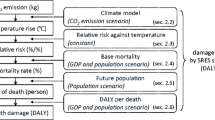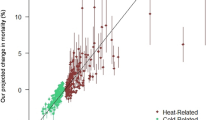Abstract
Purpose
Frequent updates on the evaluation of health risks associated with climate change are made. The existing health damage factors associated with CO2 emission are based on the findings compiled by the 2004 World Health Organization (WHO) report. An updated version of the 2014 WHO report is now available, and based on its contents, this study aimed to estimate relative risk (RR) and calculate health damage factors for each shared socioeconomic pathway (SSP) scenario.
Methods
Damage factors (DALY/kg-CO2) were calculated as increment of temperature (°C/kg) multiplied by increment of RR per °C, base mortality rate without climate change (−), population, and disability-adjusted life year (DALY) per case of death. RRs and base mortality rates were calculated for each SSP scenario. RRs by SSP scenario were estimated based on the RRs of three economic growth scenarios (high growth, base case, and low growth), which were calculated based on the results of the 2014 WHO report. Base mortality rates for each SSP scenario were calculated based on its relationship with gross domestic product per capita.
Results and discussion
In relation to undernutrition, diarrhea, malaria, dengue, heat stress, and coastal floods, the health damage factors (DALY/kg) for the SSP1, SSP2, and SSP3 scenarios were 1.3 × 10−6, 1.5 × 10−6, and 2.0 × 10−6, respectively. During a 100-year evaluation period, the damage factors obtained in the current study were 3–5 times higher than those in previous studies mainly because relative risk per degree Celsius (RR/°C) in the 2014 WHO report was larger than that in the 2004 WHO report. When RRs were estimated for each SSP scenario, the RR of SSP3 (with higher base mortality) was relatively low, particularly in case of undernutrition. Therefore, differences in the damage factors between the scenarios were more likely smaller than before when a single RR was used.
Conclusions
New health damage factors for the SSP1, SSP2, and SSP3 scenarios were estimated using an updated RR calculated based on the 2014 WHO report. These factors can be further updated in the future using RRs obtained from upcoming researches on climate-related health impact that were based on SSP scenarios.






Similar content being viewed by others
References
De Schryver AM, Brakkee KW, Goedkoop MJ, Huijbregts MA (2009) Characterization factors for global warming in life cycle assessment based on damages to humans and ecosystems. Environ Sci Technol 43(6):1689–1695
Ezzati M, Lopez AD, Rodgers A, Murray CJL (2004) Comparative quantification of health risks. Global and regional burden of diseases attributable to selected major risk factors. World Health Organization, Geneva
Hales S, Kovats RS, Lloyd S, Campbell-Lendrum D (eds) (2014) Quantitative risk assessment of the effects of climate change on selected causes of death, 2030s and 2050s. World Health Organization (WHO), Geneva
Hanasaki N et al (2013a) A global water scarcity assessment under shared socio-economic pathways: I. Water use. Hydrol Earth Syst Sci 17:2375–2391
Hanasaki N et al (2013b) A global water scarcity assessment under shared socio-economic pathways: II. Water availability and scarcity. Hydrol Earth Syst Sci 17:2393–2413
Hasegawa T, Fujimori S, Takahashi K, Masui T (2015) Scenarios for the risk of hunger in the twenty-first century using shared socioeconomic pathways. Environ Res Lett 10. https://doi.org/10.1088/1748-9326/10/1/014010
International Institute for Applied Systems Analysis (IIASA) (2016) SSP Database - Version 1.1. https://tntcat.iiasa.ac.at/SspDb. Accessed 19 May 2017
IPCC (2007) Climate Change 2007: The Physical Science Basis. In: Solomon S, Qin D, Manning M, Chen Z, Marquis M, Averyt KB, Tignor M, Miller HL (eds) Contribution of Working Group I to the Fourth Assessment Report of the Intergovernmental Panel on Climate Change. Cambridge University Press, Cambridge 996 pp
IPCC (2013) Climate Change 2013: The Physical Science Basis. In: Stocker TF, Qin D, Plattner G-K, Tignor M, Allen SK, Boschung J, Nauels A, Xia Y, Bex V, Midgley PM (eds) Contribution of Working Group I to the Fifth Assessment Report of the Intergovernmental Panel on Climate Change. Cambridge University Press, Cambridge, 1535 pp. https://doi.org/10.1017/CBO9781107415324
IPCC (2014) In: Field CB, Barros VR, Dokken DJ, Mach KJ, Mastrandrea MD, Bilir TE, Chatterjee M, Ebi KL, Estrada YO, Genova RC, Girma B, Kissel ES, Levy AN, MacCracken S, Mastrandrea PR, White LL (eds) Climate Change 2014: Impacts, adaptation, and vulnerability. Summaries, frequently asked questions, and cross-chapter boxes. A contribution of working group II to the fifth assessment report of the intergovernmental panel on climate change. World Meteorological Organization, Geneva 190 pp
Kii M, Akimoto K, Hayashi A (2013) Risk of hunger under climate change, social disparity, and agroproductivity scenarios. Environ Model Assess 18:299–317
Mathers CD, Loncar D (2005) Updated projections of global mortality and burden of disease, 2002–2030: data sources, methods and results. WHO, Geneva
Mathers CD, Loncar D (2006) Projections of global mortality and burden of disease from 2002 to 2030. PLoS Med 3(11):2011–2030
Murray CJL (1996) Rethinking DALYs. In: Murray CJL, Lopez AD (eds) The global burden of disease, Global Burden of Disease and Injury Series, vol 1. Harvard University Press, Cambridge, pp 1–98
O’Neill B, Kriegler E, Riahi K, Ebi K, Hallegatte S, Carter T, Mathur R, Vuuren D (2014) A new scenario framework for climate change research: the concept of shared socioeconomic pathways. Clim Chang 122:387–400
Tang L, Ii R, Tokimatsu K, Itsubo N (2015) Development of human health damage factors related to CO2 emissions by considering future socioeconomic scenarios. Int J Life Cycle Assess. https://doi.org/10.1007/s11367-015-0965-9
United Nations (UN), Department of Economic and Social Affairs, Population Division (2011). World population prospects: the 2010 revision, volume I: comprehensive tables. ST/ESA/SER.A/313
Van Vuuren DP et al (2014) A new scenario framework for climate change research: scenario matrix architecture. Clim Chang 122(3):373–386
Van Zelm R, Huijbregts MAJ, Den Hollander HA, Van Jaarsveld HA, Sauter FJ, Struijs J, Van Wijnen HJ, Van de Meent D (2008) European characterization factors for human health damage due to PM10 and ozone in life cycle impact assessment. Atmos Environ 42(3):441–453
WHO (2017a) CAUSE-SPECIFIC MORTALITY http://www.who.int/healthinfo/global_burden_disease/estimates/en/index1.html. Accessed 10 May 2017
WHO (2017b) DISEASE BURDEN http://www.who.int/healthinfo/global_burden_disease/estimates/en/index2.html. Accessed 10 May 2017
Wigley TML (2008) MAGICC/SCENGEN 5.3: USER MANUAL (version 2). http://www.cgd.ucar.edu/cas/wigley/magicc/UserMan5.3.v2.pdf. Accessed 8 April 2017
Acknowledgements
We thank Dr. Sophie Bonjour and Dr. De. Colin Mathers for providing us the data of base mortality and population. This study was supported by the Environmental Research and Technology Development Fund (S-14) of the Ministry of the Environment of Japan.
Author information
Authors and Affiliations
Corresponding author
Additional information
Responsible editor: Masaharu Motoshita
Publisher’s Note
Springer Nature remains neutral with regard to jurisdictional claims in published maps and institutional affiliations.
Electronic supplementary material
ESM 1
(PPTX 219 kb)
Rights and permissions
About this article
Cite this article
Tang, L., Furushima, Y., Honda, Y. et al. Estimating human health damage factors related to CO2 emissions by considering updated climate-related relative risks. Int J Life Cycle Assess 24, 1118–1128 (2019). https://doi.org/10.1007/s11367-018-1561-6
Received:
Accepted:
Published:
Issue Date:
DOI: https://doi.org/10.1007/s11367-018-1561-6




